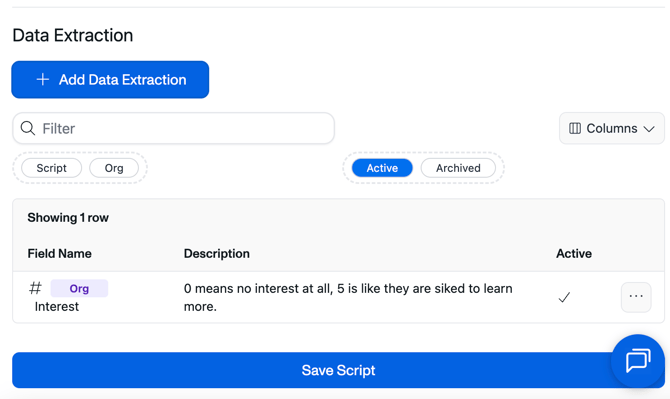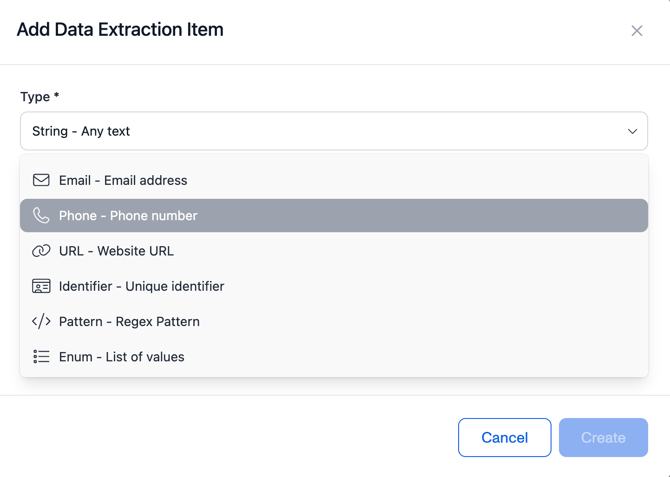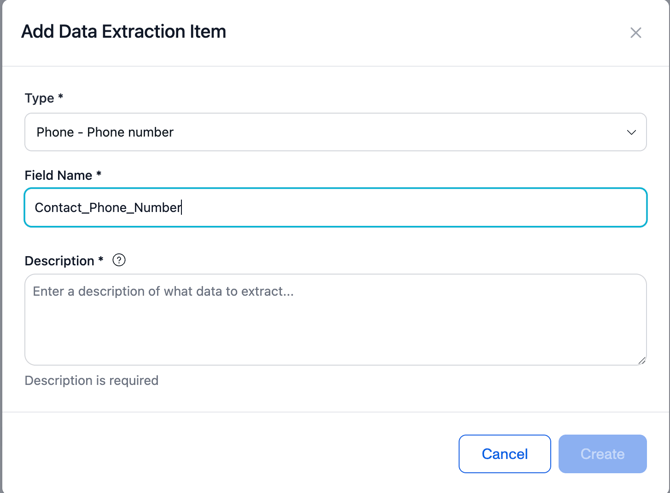How to Set Up Data Extraction Fields in Gail
Data extraction automatically pulls specific information from every call, eliminating manual note-taking and making important details instantly accessible. This guide will walk you through setting up custom data extraction fields for your insurance business.
What is Data Extraction?
Data extraction captures key information from your calls automatically. Instead of listening back through recordings or taking manual notes, the data you need is already organized and ready to use.
Key Benefits:
- No more hunting through call recordings for specific details
- Automatic capture of callback times, policy interests, and budget ranges
- Instant access to organized customer information
- Consistent data collection across all calls
Getting Started
Step 1: Access the Data Extraction Section
Navigate to any of your script configuration pages where you'll see the Data Extraction section below your Text Script settings.

Step 2: Add Your First Data Extraction Field
Click the "+ Add Data Extraction" button to create a new field.
Step 3: Configure Your Field
The configuration dialog will appear with three required settings:


1. Select the Field Type
Choose the type that matches the data you want to extract:
- String - Any text (default option)
- Email - Email addresses with automatic validation
- Phone - Phone numbers with proper formatting
- URL - Website addresses
- Identifier - Unique identifiers like policy or claim numbers
- Pattern - Custom regex patterns for specific formats
- Enum - Predefined list of values (great for categories)
2. Name Your Field
Enter a clear, descriptive name using underscores for spaces (e.g., Contact_Phone_Number)
3. Add a Description
Provide clear instructions on what data to extract. This description guides the extraction process, so be specific about:
- What information to capture
- How it will be used
- Any special formatting requirements
Step 4: Save Your Field
Click "Create" to add the field to your extraction list. The field will now appear in your active fields table.
Recommended Fields for Insurance Agencies
Based on industry best practices, here are the essential data extraction categories and fields to consider:
📞 Caller & Contact Information
- Caller Name - Full name for identification and personalization
- Contact Phone Number - For follow-up communications
- Contact Email Address - For digital communications
- Policy Holder Name - To verify authorization
🎯 Call Intent & Routing
- Caller Type - Current Client, New Prospect, or Mortgage Company
- Inquiry Type - New Quote, Cancellation, Claim, Policy Change, or General
- Type of Coverage - Auto, Home, Life, Health, or Commercial
- Product/Service Mentioned - Specific products discussed
💼 New Business & Quotes
- Desired Coverage Type - Vehicle, Home, Business, Life, or Health
- Personal/Business Policy - For proper agent assignment
- Desired Coverage Limits - Initial quote parameters
- Property Address - For home insurance quotes
- Property Occupancy Type - Primary, Secondary, or Rental
📋 Existing Policy Management
- Policy Number - Unique policy identifier
- Effective/Expiration Dates - Coverage period
- Premium Amount - Cost and payment status
- Change Request Type - Add vehicle, update address, increase limits
🔧 Claims Management
- Claim Number - Existing claim identifier
- Reason for Claim - Nature of the incident
- Home Claim Nature - Water, Fire, Theft, or Storm damage
❌ Policy Cancellation
- Cancellation Reason - Price, Service, Found Better Coverage, or No Longer Needed
📊 Call Performance
- Sentiment - Positive, Neutral, or Negative tone
- Action Items - Required follow-up tasks
- Resolution Status - Whether the issue was resolved
Managing Your Fields
Once created, your fields appear in the Data Extraction table where you can:
- View all active fields with their descriptions
- Toggle fields on/off using the Active checkbox
- Edit field settings by clicking on the field name
- Filter by Script or Organization level fields
- Archive unused fields to keep your list organized
Best Practices
✅ Do:
- Start with 5-10 essential fields and expand gradually
- Use clear, consistent naming conventions
- Write detailed descriptions for accurate extraction
- Review extracted data regularly to refine descriptions
- Group related fields logically
❌ Don't:
- Create duplicate fields with similar purposes
- Use vague descriptions that could capture multiple data types
- Overwhelm the system with too many fields initially
- Forget to test new fields with actual calls
Tips for Success
- Start Simple: Begin with the most critical information you need from every call
- Use Enum Types: For fields with limited options (like Caller Type), use Enum to ensure consistency
- Test and Refine: Monitor the extracted data and adjust descriptions for better accuracy
- Think About Reporting: Create fields that will be useful for analytics and reporting
- Train Your Team: Ensure everyone understands what data is being captured automatically
Need Help?
- Check the help center for detailed documentation
- Contact support if you need assistance with complex field configurations
- Review your extracted data regularly in the call logs to ensure accuracy
Remember: Data extraction works best when fields are well-defined and descriptions are clear. Take time to plan your fields before creating them, and adjust as you learn what works best for your business.
Note: Data extraction is live and begins working immediately after you save your script. All new calls will have the configured fields extracted automatically.